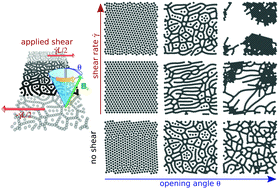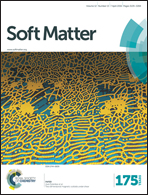Two-dimensional magnetic colloids under shear†
Abstract
Complex rheological properties of soft disordered solids, such as colloidal gels or glasses, inspire a range of novel applications. However, the microscopic mechanisms of their response to mechanical loading are not well understood. Here, we elucidate some aspects of these mechanisms by studying a versatile model system, i.e. two-dimensional superparamagnetic colloids in a precessing magnetic field, whose structure can be tuned from a hexagonal crystal to a disordered gel network by varying the external field opening angle θ. We perform Langevin dynamics simulations subjecting these structures to a constant shear rate and observe three qualitatively different types of material response. In hexagonal crystals (θ = 0°), at a sufficiently low shear rate, plastic flow occurs via successive stress drops at which the stress releases due to the formation of dislocation defects. The gel network at θ = 48°, on the contrary, via bond rearrangement and transient shear banding evolves into a homogeneously stretched network at large strains. The latter structure remains metastable after switching off of the shear. At θ = 50°, the external shear makes the system unstable against phase separation and causes a failure of the network structure leading to the formation of hexagonal close packed clusters interconnected by particle chains. At a microcopic level, our simulations provide insight into some of the mechanisms by which strain localization as well as material failure occur in a simple gel-like network. Furthermore, we demonstrate that new stretched network structures can be generated by the application of shear.


 Please wait while we load your content...
Please wait while we load your content...